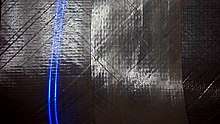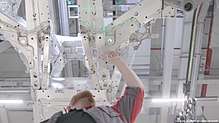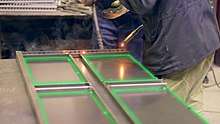Laser projector
A laser projector is a device that projects changing laser beams on a screen to create a moving image for entertainment or professional use. It consists of a housing that contains lasers, mirrors, galvanometer scanners, and other optical components. A laser projector can contain one laser light source for single-color projection or three sources for RGB (red, green, and blue) full color projection.
Lasers offer potentially brighter projected images, with more and better colors.



Types of laser projectors
There are actually two types of Laser projectors:
- Industrial Laser Projectors
- Home entertainment Laser Projectors
Industrial Laser Projectors
The industrial laser projectors are on the market since about 2002/2003. Laser projectors are mainly used as optical guidance systems. They enable working without templates in many manufacturing processes by showing directly on the workpiece how material needs to be positioned or mounted. Like that, the employee is led by manual or semiautomatic productional processes visually.
Advantages
- Fast and stable projection with high repetition rate (50 Hz)
- Optimised for 2D and 3D objects
- Highest accuracy of projection
- Wide optical angle (80° x 80°) allows bigger working sites
- Multi-projection system for huge and complex projections
Industries
- Blades for wind turbines
- Assembly support and workpiece control in 3D
- Laminated beam manufacturing
- Boat construction
- Caravan construction
- Gluing tables - CNC-BAZ - rip saws (stair construction)
- Nail truss
- Paper rolls
- Cable harness production
- Aerospace
- Leather nesting
- CNC machining centre
- Alignment of steel plates
- Inspection of metal surfaces
- Laser-supported placement of formwork for concrete steps
- Prefabricated concrete parts: Wall and ceiling elements
Depending on material to project on different colors can be used.
Home entertainment Laser Projectors
.jpg)
Home entertainment laser projectors have been on the market since about 2015. These devices are able to generate any wavelength of light, thus making wider color gamuts possible without compromising brightness. This translates to deeper, richer colors that come closer than previous products to the vast range of colors human eyes can process. Other benefits include fast (up to instant) on/off and increased longevity: One manufacturer, for example, claims 30,000 hours for the lasers in one of their mainstream models. Compared to the roughly 3,000 hours most home projectors achieve with their UHP lamps. Costing around $250 to $400 per lamp, considerable savings can be achieved over the lifetime of the projector.[1]

Advantages of this method
- Material and time saving by an optimized workflow
- Immediate visual quality control
- Rise in productivity
- Laser projection with high representation precision and quality
Typical components
Laser Diodes (Direct Injection)
Solid State DPSS (Diode-Pumped, Frequency-Doubled)
- Red: 671 nm
- Green: 532 nm
- Blue: 473 nm, 457 nm
Gas lasers
Galvanometer scanners
Galvanometers (also called "scanners" or "galvos")are computer-controlled electromagnetic devices that move mirrors mounted on the end of rotary shafts. The mirror reflects the laser beam to "draw" images. Galvanometers are typically identified by their speed of operation, measured in Kpps (kilo points per second). Available speeds include 8k, 12k, 20k, 30k, 35k, 50k, and 60k. The faster the galvanometers, the smoother and more flicker-free the projected image. Each galvanometer moves the beam in one plane, either X axis or Y axis. Placing the galvanometers close together at 90 degrees to each other allows full movement of the laser beam within a defined square area. The most useful specifications of a galvanometer pair for laser show use are the speed at which they can draw points, and the angle at which they achieve this speed. Galvanometers come in two main groups: open loop and closed loop. Closed loop, which is most common, means the galvanometer is controlled by a servo system—the control circuit uses a feedback signal generated by the mirror's motion to correct motion commands. An amplifier similar to an audio power amplifier drives the mirror.
Controller (DAC)
In the case of using a computer to control a laser projector, a Digital-to-analog converter (DAC) is needed to convert the digital control signal from the computer into analog signals that control the scanners in the laser projector. Typically, 2 channels are used for x-y position control and 3 channels are used for controlling the RGB values of an RGB projector. In the case of a single color projector, the intensity channel is used instead of the RGB channels. Most commercially available projectors and DACs are compatible with the ILDA standard that specifies the channels and pinout for the 25-pin D-SUB input connector on the projector.
DMX
Many laser projectors and galvanometer sets include Digital Multiplexing (DMX) input. DMX was originally designed to control theatrical lighting, but has spread to laser projectors over the years.
DMX allows the user to control the inbuilt patterns of the projector. A few of these features are Size, pattern, colour and rotation. However, DMX Does Not let you design and display your own graphics/animations, it is simply just a way of controlling the patterns included in your laser projector. A Digital to Analog Converter (DAC) is required for custom graphics/animations.
Dichroic Mirrors
A dichroic mirror is a mirror with different reflection or transmission properties at two different wavelengths. Typical dichroic mirrors used in laser projectors pass red light and reflect green and blue, or pass green light and reflect red and blue. Dichroic mirrors are required for combining laser beams of different colors, e.g. to combine the red, green and blue beams into a single white-light beam. The individual red, blue and green lasers are then controlled in brightness (modulated) to produce any desired color in the final beam. A typical analog-modulated RGB projector has 256 brightness levels for each laser. This gives (256 x 256 x 256) 16,777,216 different available colors (the same as a modern computer monitor).
Typical terminology
Blanking
Blanking is a state in which the laser beam turns off while the mirrors change position while creating the image. Blanking typically happens hundreds of times per second. New solid state lasers use direct electronic control of the laser source to provide blanking. With gas lasers, such as argon or krypton, this was not possible, and blanking was carried out using a third galvanometer that mechanically interrupted the beam. New technology brought a Poly-Chromatic Acousto-Optic Modulator, or PCAOM, which provided high-speed electronic blanking, intensity control, and color selection of a multi-color laser beam.
Modulation
Most DPSS lasers used in laser projectors support modulation. Modulation has to do with blanking but is a slightly broader term. A DPSS laser supports either analog modulation, TTL modulation' or both. Modulation is usually specified in terms of kHz. 2 kHz can be considered low and 30 kHz can be considered high. Manufacturers do not specify an exact relationship between this number and the behavior of the laser.
Analog modulation
An analog signal is used to control the intensity of the output beam. This signal is usually a voltage in the range of 0 V to 5 V. With an RGB laser and analog modulation there are, with an 8 bit system, 16.7 million colours at one's disposal.
However, since most laser show software uses a 0-100% control for laser brightness modulation (so 100 steps instead of 255), the total of available colours at disposal is 1'000'000. Furthermore, usual laser sources start lasing at a voltage between 1-2 volts and reach their full brightness at voltages between 3.5-4V, and the power/voltage curve between these points are usually not perfectly linear. Consequently, the dynamics of the color palette in a real lasershow use is decreased to only a few thousands of different colors.
TTL Modulation
TTL modulation indicates that the laser does not support analog modulation of the output but only ON / OFF control. See blanking. With an RGB laser and TTL blanking you have seven colours at your disposal. Red, Green, Blue, Cyan, Magenta, Yellow, White.
ILDA
The International Laser Display Association. A trade association dedicated to promoting the use of laser displays.
Scan angle
Scan angle is the optical angle that a set of scanners normally achieves at a given rate of points per second. The wider the angle, the larger the area the scan covers—but the more difficult it is for the scanner accurately track due to physical limitations of the scanner mechanism. For example, a 20 degree angle provides a 3.5 metre scanned area at a distance of 10 metres from scanner to screen. Scan angles can be calculated using standard trigonometry.
See also
References
- ↑ CNET